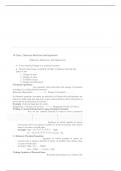Overall role of the endocrine
system Functions: Control of pituitary hormone release; interface between events
inside and outside the body and their endocrine response (from other glands)
Metabolism, water &
electrolyte balance Hormones: Corticotropin Releasing Hormone, Thyrotropin Releasing
Hormone, Somatostatin, Gonadotropin Releasing Hormone, Prolactin
Stress response: physiological
and psychological Releasing Hormone, Prolactin inhibiting factor.
Growth and development
Red blood cell production
Coordination of circulation
Coordination of digestion
There is no axis asset for prolactin or
growth hormone as these go straight to
their target cells
Anterior pituitary gland
Functions: Controls activity of other endocrine
glands; ovulation and pregnancy; sperm
production; growth
Hormones: Thyroid Stimulating Hormone;
Adrenocorticotropic hormones - ACTH;
Luteinising Hormone; Follicle Stimulating
Hormone; Growth Hormone; Prolactin
Posterior pituitary gland
Functions: Involved in regulating overall water balance; uterine
contraction; ejection of milk
Hormones: Antidiuretic Hormone/vasopressin; Oxytocin
There are 4 different types of Endocrine Thyroid gland
Located in the neck area and made of
receptor. Ligand-gated ion channels 2 lobes joined by the isthmus. The
Adrenal glands
– change membrane potentials
through ions
system
Located above each kidney, outer follicular cells secrete
embedded in a capsule of fat. thyroglobulin (parent structure) which
G-protein coupled receptors- ligand is then used to make thyroxine (T4)
binds, GDP -> GTP. Phosphorylation Adrenal cortex: Steroid hormones
(cortisol, aldosterone and and triiodothyronine (T3) through the
Enzyme-linked receptors – ligand addition of iodides by
bins, modifies the receptor and androgens)
Adrenal medulla: Consists of thyroperoxidase in the colloid region.
causes further reactions They are considered a unit because T4
Intracellular receptors – when a modified postganglionic neurones
– Chromaffin cells and contains 2 is initially produced for its higher
hormone binds they act as affinity to plasma proteins for its
transcription factors types of secretory cells to produce
adrenaline (80%) and transport, then it’s converted to T3
Pancreas noradrenaline (20%). which has a higher affinity for its
Contains 2 types of cells in its Islets These hormones bind to receptor inside the cell.
of Langerhans. α cells release adrenergic receptors (a GPCR) for Unlike the HPG axis the levels of the
glucagon (glycogen breakdown) and which there are divisions which thyroid hormones is relatively stable
β cells release insulin. use different 2° messengers. apart from at birth where the sudden
Insulin increases glycogenesis, β1, β2 use cAMP. β1= excitatory exposure to the colder environment
lipogenesis and protein synthesis effect only on heart cells. Β2= causes lots of TRH release. Its levels
from glucose. 2 insulin molecules inhibitory effect- decreasing are maintained by a negative
bind to a tyrosine kinase receptor smooth muscle contraction in feedback by T3 and T4 on TSH
allowing dimerization. This arteries and bronchioles production by the anterior pituitary.
phosphorylates tyrosine residues α1 uses IP3 and Ca2+, and α2 Functions: Increasing metabolic rate
and then also other proteins in inhibits cAMP. α1= excitatory and heat production,
signalling pathways, one of which effect on blood vessel contraction. sympathomimetic effect and its
activates PI3 Kinase bringing GLUT4 α2= inhibitory effect- decreasing effects on the CV and nervous system
into the membrane for glucose smooth muscle contraction in the and growth.
uptake. digestive system











